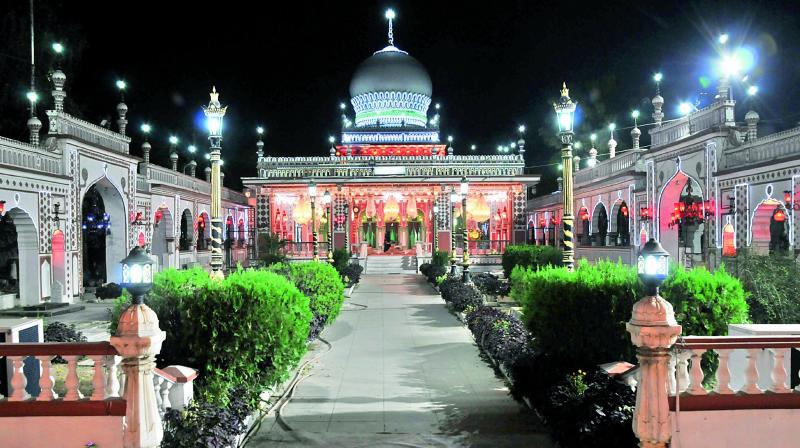Illuminated Aghapura Dargah is a delight

Hyderabad: Amidst the mayhem with the traffic rules broken at will, a lane leads to a quiet, peaceful tomb of Hazrat Shah Mohammed Hasan Sahib Qibla or the famous Aghapura dargah.
In the main dargah lies the tomb of the saint who traces his origin to a family of saints in Iran. After staying in Bidar, the saint moved to Hyderabad. The ceiling is adorned with many chandeliers and the hanging lamps are kept a foot away from one another. Once these chandeliers and lights are lit, the visitor feels like being in an isle of light.
The dargah turns into a bright-beauty on the Urs day every month. Sultan Salahuddin Owaisi, a major political figure belonging to the All India Majlis-e-Ittehadul Muslimeen Party, also rests peacefully.
Among these hanging beauties lies the 150-year-old chandelier churned out by Baccarat Company, Osler Company and a French firm.
This red chandelier with a delicate 24-carat gold design is still in its pristine condition and owes a lot to Shah Agha Mohd Qasim Abul Ullai, Muttawali at the dargah, a 6th generation of Agha Dawood Saheb, a follower of the Hazrat.
In fact, it was due to Agha Dawood Saheb, the area assumed the name Aghapura. Agha Dawood Saheb was the caliph or a successor chosen by the great saint.
“I am particular that the dargah looks flawless. In fact, I made it a point that there is no fused bulb unattended in any chandeliers even in the midst of a Qawalli session,” noted Hazrat, who said the candle bulbs are not easily available, forcing him to keep a stock of them.
At the Sama Khana, gorgeous-looking chandeliers steal the show when the Qawalli sessions are held here. Earlier, it was open but now a huge glass door covers this room — carpeted and well-lit.
The Sama Khana predates the tomb by almost 20 years. The large span and the sweeping curve of its main arch are a tribute to the genius of its builder.
Though Agha Dawood Saheb bought a huge chunk of land, 22 acres all that is left is around the dargah nine acres.
The Sama Khana is a huge hall with unsupported arches. Those who were building it said that they could not proceed further, but Agha Saheb insisted and stood there all the time, telling them what to do.
There are also regular chandeliers in green, red, blue and milky white colours, made specifically for the Asian market. But what is striking is that the light in each of these chandeliers shimmers differently, resulting in an amalgam of striking colours and the light.
Huge trees adorn the surroundings of the dargah and lend shade to all the tombs. There is an old well and the canal meant to bring the water is covered with dry leaves and branches.
In old days, the dargah was pristine white. In 2014, when the 150th Urs was celebrated, it was interspersed with a beautiful russet brown.
Because of this colour, the stucco work, the relief work, the geometric designs and the floral patterns stand out and reflect in the light flashed from the top.
The tomb is an enclosed shrine and women are not allowed to step into the room. However, they can worship from outside and can peer through the jalis on the doors surrounding the room. The pillars in and around the dargah are traditional and reminiscent of the Kerala or the Chettinad wooden pillars.
Designed with great love, these pillars lend an old look to dargah. Even the brackets in many of the places, including the Sama Khana, the Khankha behind the dargah and within the dargah, are vernacular.
It bagged the Intach Award in 2004, and the citation said, “Prime example of the resurgence of the vernacular architectural style, which gained popularity during the reign of the sixth Nizam Mir Mahboob Ali Khan, reflecting the revival of the Qutb Shahi style with the Mughul elements like cusped arch incorporated. It was the forerunner of the Osmanian style.”
Behind the main building of the dargah is the 200-year-old Khankha, which is a building dedicated specifically for the gathering of the Sufi brotherhood — a place for spiritual retreat and prayers.
It has cusped arches all around. A few additions have also taken place here of late. Earlier, the place was open but now safety tools are put in place. The Khankha also has chandeliers. The tomb of the saint is enclosed in a room, the family members’ tombs are outside.

